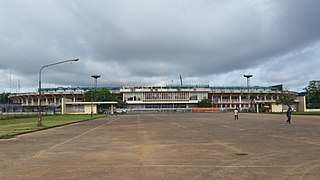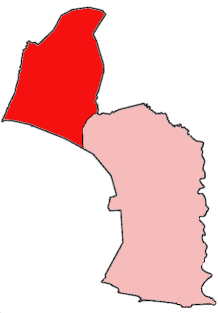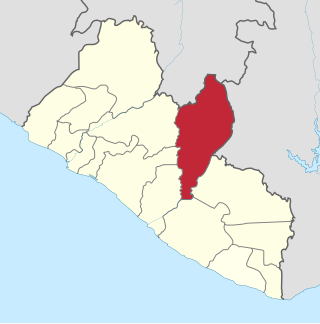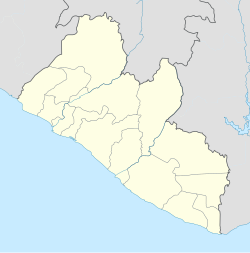
The Politics of Liberia takes place in a framework of a presidential representative democratic republic modeled on the government of the United States, whereby the President is the head of state and head of government; unlike the United States, however, Liberia is a unitary state as opposed to a federation and has a pluriform multi-party system rather than the two-party system that characterizes US politics. Executive power is exercised by the government. Legislative power is vested in both the government and the two chambers of the legislature.

Samuel Kanyon Doe was a Liberian politician who served as the 21st president of Liberia from 1986 to 1990. He ruled Liberia as Chairman of the People's Redemption Council (PRC) from 1980 to 1986 and then as president from 1986 to 1990.
Prince Yormie Johnson is a Liberian politician who has served as a senator for Nimba County since 2006. A former rebel leader, Johnson played a prominent role in the First Liberian Civil War.

The president of the Republic of Liberia is the head of state and government of Liberia. The president serves as the leader of the executive branch and as commander-in-chief of the Armed Forces of Liberia.

The First Liberian Civil War was the first in a series of two civil wars within the West African nation of Liberia. It lasted from 1989 to 1997. President Samuel Doe established a regime in 1980 but totalitarianism and corruption led to unpopularity and the withdrawal of support from the United States by the late 1980s. The National Patriotic Front of Liberia (NPFL) led by Charles Taylor invaded Liberia from the Ivory Coast to overthrow Doe in December 1989 and gained control over most of the country within a year. Doe was captured and executed by the Independent National Patriotic Front of Liberia (INPFL), a splinter faction of the NPFL led by Prince Johnson, in September 1990. The NPFL and INPFL fought each other for control of the capital city, Monrovia and against the Armed Forces of Liberia and pro-Doe United Liberation Movement of Liberia for Democracy. Peace negotiations and foreign involvement led to a ceasefire in 1995 but fighting continued until a peace agreement between the main factions occurred in August 1996. Taylor was elected President of Liberia following the 1997 Liberian general election and entered office in August of the same year.

General elections were held in Liberia on 19 July 1997 as part of the 1996 peace agreement ending the First Liberian Civil War. The presidency, as well as all seats in the House of Representatives and the Senate were up for election. Voter turnout was around 89%. Former rebel leader Charles Taylor and his National Patriotic Party (NPP) won the election with 75.3% of the vote, giving it about three-quarters of the legislative seats according to the proportional representation system. Taylor was inaugurated as president on 2 August 1997.
The National Patriotic Front of Liberia (NPFL) was a Liberian rebel group that initiated and participated in the First Liberian Civil War from 24 December 1989 – 2 August 1997. The NPFL emerged out of rising ethnic tensions and civil unrest due to the Liberian government that was characterized by totalitarianism, corruption, and favoritism towards ethnic Krahns. The NPFL invaded Liberia through Ivory Coast’s border with Nimba County in Liberia under the direction of Charles Taylor, a former Liberian politician and guerrilla leader who served as the 22nd president of Liberia from 2 August 1997 until his resignation on 11 August 2003.
AlhajiGarxim Varmuyan Kromah was a Liberian journalist who became a warlord and leader of the ULIMO faction during the Liberian Civil War. He was a Muslim and member of the Mandingo ethnic group from Tusu Town, Quardu Gboni District, Lofa County. He attended St. Patrick's High School (1973).

General elections were held in Liberia on 15 October 1985. They were the first elections since the 12 April 1980 military coup that brought Samuel Doe to power. During 1984, a new draft constitutional was approved in a referendum, which provided for a 58-member civilian and military Interim National Assembly, headed by Samuel Doe as president. After a ban on political parties was lifted, four parties – Doe's National Democratic Party (NDP), the Liberian Action Party, the Unity Party and the Liberia Unification Party – contested the elections.
Sekou Damate Conneh, Jr. is a Liberian politician and former rebel leader.
Gabriel Bacchus Matthews was a Liberian politician. He is considered one of the leaders in developing a multi-party system in Liberia, long dominated by the True Whig Party. He founded the Progressive Alliance of Liberia (PAL) in 1975, the first active opposition party since the demise of the Republican Party.

The Samuel Kanyon Doe Sports Stadium is a multi-purpose stadium which is part of the Samuel Kanyon Doe Sports Complex in Paynesville, Liberia, a suburb of the country's capital, Monrovia. Built in 1986, it is used mostly for football matches and has an athletics track, though it has also been used for a reggae concert, political rallies, IDP refuge, and Ebola treatment. The largest stadium in Liberia, its spectator capacity is 22,000.

Barrobo District is a district of Liberia, one of the three located in Maryland County.
Henry Boimah Fahnbulleh, Jr. is a Liberian politician and diplomat. He most recently served in the Liberian Government as National Security Advisor in the Ellen Johnson Sirleaf administration. Immediately previous to his appointment as National Security Advisor, he served as Advisor on International Affairs in the same government. He served as Foreign Minister from 1981 to 1983 under President Samuel Doe.

Kparblee District is one of 17 Administrative Districts of Nimba County, Liberia. In 2008, the population was 11,424. It is located in Tappita Statutory District and situated along the Cestos River which borders Liberia with the Republic of Côte d'Ivoire, commonly called the Ivory Coast.
Emmanuel N. Gbalazeh served as the 16th Chief Justice of Liberia from 1988 until the collapse of the Liberian government in September 1990. He had previously served as the Chief Justice of the People's Supreme Court under the People's Redemption Council from 1980 to 1986.
Jackson Fiah Doe was a Liberian politician in the late twentieth century.

The 1980 Liberian coup d'état happened on April 12, 1980, when President William Tolbert was overthrown and murdered in a violent coup. The coup was staged by an indigenous Liberian faction of the Armed Forces of Liberia (AFL) under the command of Master Sergeant Samuel Doe. Following a period of transition, Doe ruled Liberia throughout the 1980s until his murder in 1990 during the First Liberian Civil War.
The Monrovia Church massacre, also referred to as the St. Peter's Lutheran Church massacre, was the worst single atrocity of the First Liberian Civil War. Approximately 600 people were killed at the church, on 14th Street, in the Sinkor district of Monrovia on 29 July 1990. The massacre was carried out by approximately 30 government soldiers loyal to President Samuel Doe. The perpetrators were of Doe's Krahn tribe while most of the victims were from the Gio and Mano tribes, which were in support of the rebels.
Nancy Bohn Doe is a former First Lady of Liberia.









